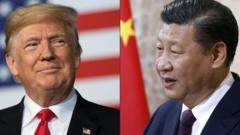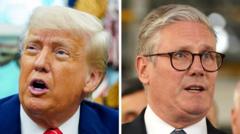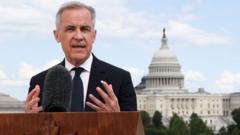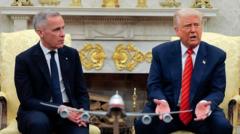In a surprising twist in the ongoing US-China trade war, Chinese state media reported Thursday that the United States is looking to initiate tariff discussions, revealing the underlying tension between the two economic giants. The announcement comes as tariffs on certain Chinese exports soar to alarming levels, raising concerns about a potential recession globally. Official sources indicate that President Donald Trump's administration is actively reaching out to Beijing, while China's response has highlighted its unwillingness to appear submissive in the negotiations.
US-China Trade War: A Game of Chicken as Talks Loom

US-China Trade War: A Game of Chicken as Talks Loom
Both nations' leaders face pressure as they navigate tariff negotiations amid economic uncertainties.
The intricate dynamics of this situation have led experts to compare it to a high-stakes game of chicken between Trump and Xi Jinping, each leader striving to maintain their image while negotiating an end to the trade conflict. Political analysts suggest that neither side is eager to be perceived as "giving in," as doing so could diminish their bargaining power. The deflected assertions and denials from both governments hint at a mutual desire to de-escalate tensions, yet neither is willing to take the initial step that might reveal perceived weakness.
The current scenario has fostered a tactic termed "constructive ambiguity," where both sides employ vague language to claim moral high ground in the negotiation process. Despite the lack of clarity, there is an underlying acknowledgment that a third-party mediator could facilitate dialogue and provide an exit strategy. Both leaders are also motivated by domestic considerations, seeking to frame any outcomes from the negotiations as victories to quell growing economic anxieties at home.
As trade tensions escalate, both Trump and Xi face pressures that threaten their economies. The American economy, already showing signs of contraction, adds urgency to Trump’s need for a resolution. Meanwhile, Xi’s government grapples with persistent economic challenges, including low consumption and increasing unemployment, making it essential to restore public confidence in the country's resilience.
The mutual recognition that neither side can claim total victory in these negotiations suggests a cautious optimism; possible engagements could lead to some concessions. Nevertheless, skepticism remains as both parties navigate their respective challenges while seeking to project strength in an increasingly fraught economic landscape.
Even as channels of communication appear to be opening, the road to meaningful dialogue is still complicated by the historical precedents of mistrust between the US and China. At this juncture, the focus remains on who will be the first to step away from rigid posturing and take the initiative toward a more collaborative future.
The current scenario has fostered a tactic termed "constructive ambiguity," where both sides employ vague language to claim moral high ground in the negotiation process. Despite the lack of clarity, there is an underlying acknowledgment that a third-party mediator could facilitate dialogue and provide an exit strategy. Both leaders are also motivated by domestic considerations, seeking to frame any outcomes from the negotiations as victories to quell growing economic anxieties at home.
As trade tensions escalate, both Trump and Xi face pressures that threaten their economies. The American economy, already showing signs of contraction, adds urgency to Trump’s need for a resolution. Meanwhile, Xi’s government grapples with persistent economic challenges, including low consumption and increasing unemployment, making it essential to restore public confidence in the country's resilience.
The mutual recognition that neither side can claim total victory in these negotiations suggests a cautious optimism; possible engagements could lead to some concessions. Nevertheless, skepticism remains as both parties navigate their respective challenges while seeking to project strength in an increasingly fraught economic landscape.
Even as channels of communication appear to be opening, the road to meaningful dialogue is still complicated by the historical precedents of mistrust between the US and China. At this juncture, the focus remains on who will be the first to step away from rigid posturing and take the initiative toward a more collaborative future.




















